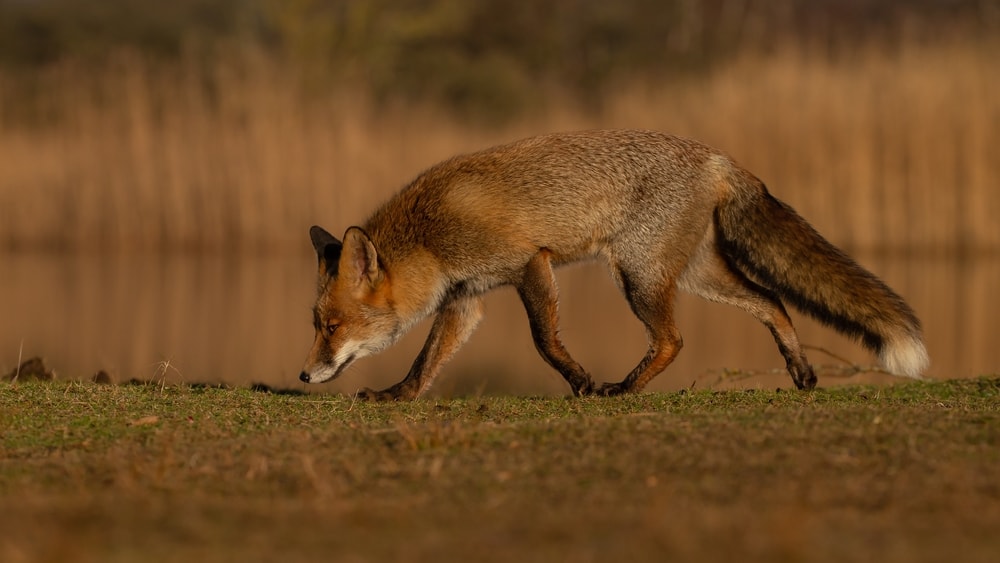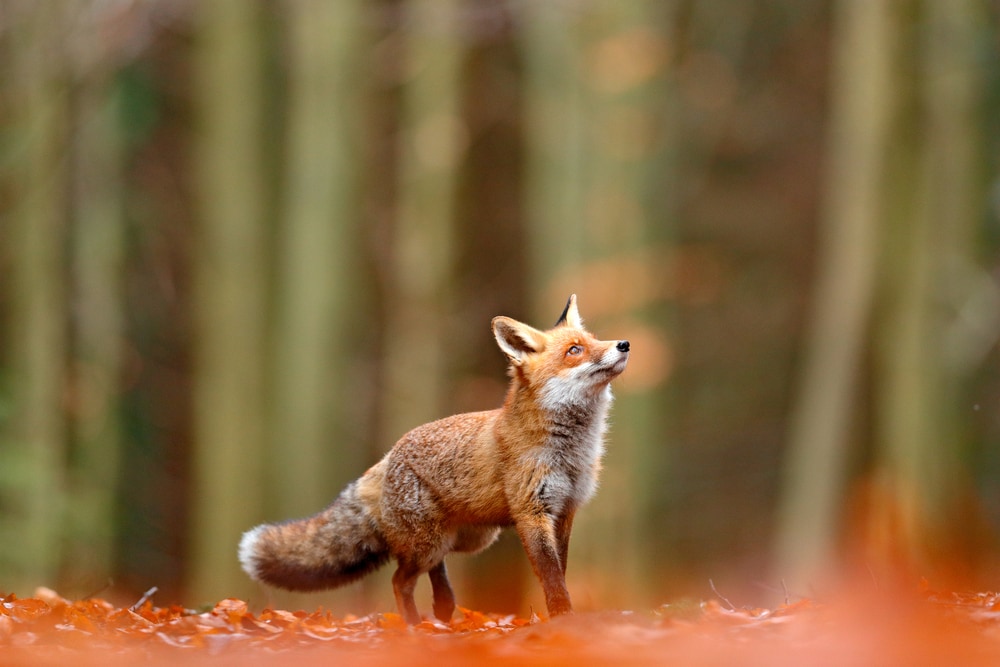Outforia Quicktake: Key Takeaways
- Foxes communicate through various sounds such as screaming, howling, barking, “wow wow wow” sounds, gekkering, laughing, and purring.
- Foxes use sounds to protect their territory, as mating calls, to greet other foxes, and to establish hierarchy.
- Apart from noises, foxes communicate through scents and body language, utilizing facial expressions and body postures.
- The red fox is the most widely distributed non-domestic carnivore in cities worldwide, and its sounds are often heard in urban areas.
- The viral song “What Does the Fox Say?” by Ylvis was a comedic take on fox sounds but did not accurately represent the real sounds foxes make.

With over 20 species of foxes, these cat-like creatures are on top of the woodland food chain. They’re so adaptable that it’s easy for them to thrive in different habitats. These habitats range from coastal areas and marshland to cities.
As nocturnal animals, they hunt primarily during the night. Have you woken up in the middle of the night by a weird sound and wondered what it was? It might have been a fox. But what sound does a fox make?
Screaming, howling, and barking are just a few ways foxes communicate. With over a dozen species worldwide, let’s look at all the sounds they make and why.
How Do You Identify a Fox?

These cunning little creatures belong to the Canidae family. While there are many species, they have a few common characteristics. This includes a bushy tail, long snout, and triangular ears. However, each species has its unique looks.
One of the most widely distributed non-domestic carnivores in cities worldwide is the red fox (Vulpes vulpes). As a result, there’s a high chance this fluffy troublemaker makes its rounds in your neighborhood.
How do you tell it’s a red fox? They will have long legs, black feet, and a long bushy tail almost reaching the ground. This tail usually has a white tip. The overall coat is gingerish, with white tones underneath.
They have triangular shaped-ears with white on the inside. The face is half ginger, while the lower part, including the cheeks and mouth, is white. Their cute noses are black.

You can also identify a fox by its footprints. Like many wild canines, fox footprints have four toes and are oval-shaped. However, a red fox leaves claw marks. Gray foxes have retractable claws, so you’d only see their toes’ footprints. You can differentiate a fox’s print from cats and dogs by drawing a diagonal cross through it.
Another way to identify a fox is through its sounds. They make many sounds depending on their mood and circumstances. These unworldly sounds include laughing, screaming, growling, and yelping.
What Sound Does a Fox Make?
Screaming to protect its territory
Any sound during the night sounds terrifying. However, a fox’s scream can make you tremble, especially if you do not know what it is.
Their night screams are so loud that everybody can hear them. Foxes are territorial, so they scream to warn predators and other foxes to leave the area. They can attack if screaming is inefficient.
Their predators are coyotes, eagles, beavers, wolves, bears, and mountain lions. Humans are also added to this list because they hunt foxes for sport or their fur.
According to the Humane Society of the United States, foxes are unlikely to attack a human. This is mostly because they are afraid of us. If a fox screams at night in your proximity, it probably thinks you are invading its territory.
Mating Calls
If it’s mating season, you are bound to hear some mating calls. These sounds are unique, and you might even want to call for help. It’s more of a loud, high-pitched howl, a piercing sound to attract possible mates.
The vixen, a female fox, will make a loud howl in the middle of the night to tell male foxes they’re ready for mating. The dog fox, another name for males, answers with a bark that sounds like “hup-hup-hup” noises.
Vixens also scream to ensure no other fox can snatch their mate. Listen to some sounds foxes make when they’re looking for a mate here.
These sounds usually start in January, and this month is the noisiest of them all. Pups are born in March, so foxes become more silent by then. Instead, they have more than 28 subtle sounds of talking.
Barking Sounds
If you hear barking in the wee hours, you might wonder what animal does that. Foxes bark for many reasons; they can bark when they play or deter predators. They also have a raspy bark when they want other foxes to go away.
Their barks are also very different from dog barks.
Foxes are highly intelligent, and they can differentiate between different types of barks. For example, they know if barking comes from a fox in their community or a fox from another group. Moreover, the bark is repeated every 3 to 10 seconds.
Wow Wow Wow Sounds
Just like humans, foxes greet other foxes too. They usually make a “wow wow wow” sound similar to an owl’s hoot. As they approach each other, their communication is like a dog’s bark but more high-pitched. This is because their body is more petite than a dog’s.
For a better visual representation, they look like two ducks clucking. It’s amazing how many animals they can mimic, from owls to ducks.
Gekkering Sounds
When fighting, foxes make multiple gekkering sounds to establish hierarchy. These sounds combine howling and yelping with a low rattling sound. They also sound like parrots arguing.
When a fox fights, it stays on its hind legs with its mouth wide open. They keep their ears upright and whiskers raised. Finally, the submissive fox lies down on the ground. They usually use sounds to avoid physical fighting. Through sound, they can show their dominance while nobody gets harmed.
The kits also use gekkering sounds when playing with each other. This way, they practice their hunting skills.
Laughing Sounds
A playful fox will make a pseudo-laughing sound to express its mood. Sure, they don’t laugh like humans; they make a squealing, sweet sound. However, wild foxes don’t usually make this sound, only tame ones.
Purring Sounds
Foxes are similar to cats when they’re content. They purr when they feel happy.
You need to be really close to hear them when this happens, as it’s not as loud as a cat’s purring. For example, a vixen will purr when its kits gather next to her. As it’s virtually impossible to hear a wild fox purr, check out the video above to hear an example of a domesticated fox purring.
You may also like: All The 23 Different Types Of Foxes: Pictures, Classification And Chart
What Are Other Ways Foxes Communicate?
Apart from noises, foxes communicate through scents and visual cues.
Scents

Foxes have a highly developed sense of smell. They incorporate this in their communication through various scents like urine and feces. They use scent to mark their territory and home range. Their odor is noticeable around people’s houses.
They leave feces all over their territory so other foxes can spot them. They even mark gates, gardens, fence posts, and ponds. If you leave anything in the garden overnight, they might also mark these items.
Their noses are so sensitive, they can smell urine from miles away. As a result, they can gather plenty of information from another fox’s urine. For example, they can find out which fox has a particular territory or if a female is ready for mating. Like dogs, male foxes lift their legs to pee and mark their territory while females crouch.
Foxes have scent glands all over their body, like their tails, paws, and butts. They will mark each other with their scent glands during mating season. Another trait similar to dogs is rolling over things to leave their odor.
Body Language

As social creatures, they use different body postures and facial expressions when meeting family members or unknown foxes. They belong to the Canid family, so their communication methods are similar to dogs’.
When two members of the same family meet, they wag their tails. Their ears are usually close to their heads, and they show their teeth, in a way similar to smiling. Then, they crouch down to show they belong to the family.
When they want to play with each other, they arch their tails and flatten their ears. If a female fox is ready to mate, it will roll on its back or lick a dog’s nose.
When aggressive, their hair stands up, and they snarl to show teeth while arching their backs. If a fox has its tail erect and its ears pricked, that one is the dominant animal. The submissive fox will always stay lower.
Facial expressions are also important. An intensive stare means dominance, while a submissive fox will look down. An open mouth usually means the fox wants to play. Young cubs greet their mother by biting her mouth or nibbling her fur.
You may also like: Kit Fox: The Amazing Desert Dweller
“What Does the Fox Say?”

This question was repeatedly asked by the Norwegian comedian group Ylvis in 2013. The music video was so catchy that it has over 1 billion views on YouTube.
The song was initially created as a gag to promote the brother’s talk show. Ylvis didn’t think the song would be a hit. Instead, they wanted to make fun of their music business. As a joke, they wanted to show they were complete failures when it comes to singing.
As the brothers tried to guess fox sounds, they went from singing “Ring-ding-ding-ding-dingeringeding” and “Wa-pa-pa-pa-pa-pa-pow” to “Joff-tchoff-tchoffo-tchoffo-tchoff” sounds.
Sadly, these sounds are silly and inaccurate. So, when they got to the recording studio, the brothers began improvising to create a funny skit. The only thing they got right is that foxes make multiple sounds depending on the situation.
Unlike the music video’s melodic tune, foxes sound more dramatic and scary. Their sounds are not attractive at all. Sometimes, they sound more like a woman screaming than an animal. Other times their calls can be similar to other animals.
When you hear a screeching sound at night, you might think it’s an owl. But it can also be a fox making a wow wow sound. So what does the fox say? It can say many things, from “leave my home alone” by barking to “I’m ready to mate” by howling.
Fox Sounds and Superstition

Many cultures attribute different symbols to foxes. For example, Native American cultures believe the fox to be a benevolent creature.
Some stories portray the fox as a god with the power to create. Other accounts speak of the fox who stole fire from heaven and brought it to humankind.
In African tradition, people believed that foxes could communicate with spirits. So when somebody was ill and in grave danger, people would get a fox and tame it to help the sick recover. Foxes were also used for home protection. Fox howls were also believed to ward off evil spirits and witches.
It is also said that if you startle a fox at the beginning of your journey, something terrible might happen. A neighbor or relative would pass away if the startled fox looks at you and barks.
But, of course, this is just superstition. When a fox barks, it only means to protect its territory.
You may also like: Gray Fox: The Elusive Tree Foxes Of North America
Fox Fun Facts

You may also like: The Arctic Fox: Master Of Camouflage
Fox FAQs

What do I do if a fox approaches me?
If a curious fox approaches you, make loud noises to scare it away. You can also clap and yell to show them that humans are dangerous.
How do I stop foxes from screaming near my house?
Some people use fox repellent to deal with screaming foxes near their homes. These devices have a motion sensor, so when a fox approaches, it will spray out a jet of water, which can scare the fox away.
What other animals scream like humans at night?
Male limpkins, a large bird species, make a high-pitched sound similar to a human screaming. Coyotes make a distress sound that also sounds like a woman screaming.
Do foxes laugh when tickled?
Only domesticated foxes are capable of making sounds that sound like laughing.







